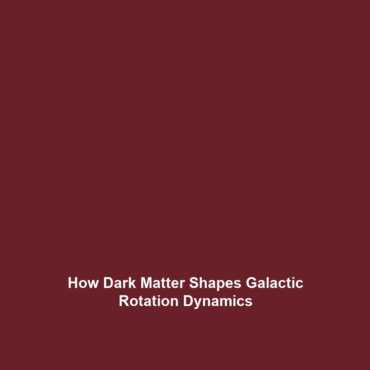How Dark Matter Influences Galactic Rotation
Dark matter plays a crucial role in the cosmos, particularly in the dynamics of galaxies. Understanding how dark matter influences galactic rotation is essential for unraveling the mysteries surrounding dark matter and dark energy. It not only enhances our understanding of the universe’s structure but also pushes the boundaries of physics. This article delves into the intricate relationship between dark matter and galactic motion, exploring its significance in the larger framework of astrophysics and cosmology.
Key Concepts of Dark Matter and Galactic Rotation
To understand how dark matter influences galactic rotation, it’s important to grasp several fundamental concepts related to dark matter and dark energy:
- Dark Matter: An enigmatic substance that does not emit, absorb, or reflect light, making it invisible. However, its presence is inferred from gravitational effects on visible matter.
- Galactic Rotation Curves: The observed velocities at which stars orbit the center of their galaxies. These curves remain flat at greater distances from the galactic center, challenging the predictions made by Newtonian physics.
- Gravitational Lensing: A phenomenon where the presence of dark matter warps space-time, causing light from distant objects to bend. This effect provides evidence of dark matter’s distribution in and around galaxies.
Applications and Real-World Uses
The understanding of how dark matter influences galactic rotation has several applications, particularly within the realm of dark matter and dark energy:
- Astronomical Modeling: Enhanced models of galactic formation and evolution incorporate dark matter’s effects, improving our understanding of galaxy behavior.
- Cosmological Studies: Insights from galactic rotation curves inform larger cosmological models, aiding in the understanding of the universe’s expansion and the role of dark energy.
- Detection Methods: Research in dark matter impacts the development of technologies for identifying dark matter particles, which can have broader implications in particle physics.
Current Challenges in Understanding Dark Matter Influence
Despite significant advancements, several challenges persist in studying how dark matter influences galactic rotation:
- Detection of Dark Matter: Direct detection remains elusive, as dark matter does not interact with electromagnetic forces.
- Theoretical Debates: Ongoing discussions regarding the nature and properties of dark matter contribute to uncertainties in galactic rotation models.
- Data Interpretation: Complications in analyzing observational data can lead to misinterpretations of galactic dynamics related to dark matter.
Future Research and Innovations
The future of research concerning how dark matter influences galactic rotation is promising, with upcoming innovations expected to shed light on longstanding mysteries:
- Advanced Telescope Technology: Next-gen telescopes are poised to provide clearer views of distant galaxies, allowing for better detection of gravitational effects attributed to dark matter.
- Particle Physics Experiments: Upcoming experiments aim to identify dark matter particles directly, potentially leading to breakthroughs in our understanding of cosmic structures.
- Computational Modeling: Innovations in computational power will enable more sophisticated simulations of galaxy formation and dark matter’s role within.
Conclusion
Understanding how dark matter influences galactic rotation is paramount in the broader study of dark matter and dark energy. As scientists continue to uncover the intricacies of dark matter, new applications and future research hold the key to deeper cosmic insights. For further reading on related topics, check our articles on Dark Energy and Galactic Dynamics.
